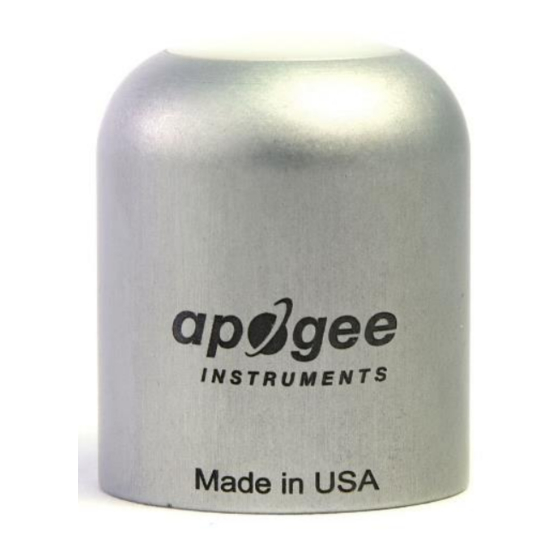
Table of Contents

Summary of Contents for Apogee SQ-614
-
Page 1: Owner's Manual
OWNER’S MANUAL EPAR SENSOR Models SQ-614 Rev: 1-Feb-2021 APOGEE INSTRUMENTS, INC. | 721 WEST 1800 NORTH, LOGAN, UTAH 84321, USA TEL: (435) 792-4700 | FAX: (435) 787-8268 | WEB: APOGEEINSTRUMENTS.COM Copyright © 2021 Apogee Instruments, Inc. -
Page 2: Table Of Contents
TABLE OF CONTENTS Owner’s Manual ....................................1 Certificate of Compliance ................................. 3 Introduction ..................................... 4 Sensor Models ..................................5 Specifications ................................... 6 Deployment and Installation ..............................9 Cable Connectors ................................... 10 Operation and Measurement ..............................10 Maintenance and Recalibration ............................. 13 Troubleshooting and Customer Support .......................... -
Page 3: Certificate Of Compliance
RoHS 3 compliant using exemption 6c. Further note that Apogee Instruments does not specifically run any analysis on our raw materials or end products for the presence of these substances, but rely on the information provided to us by our material suppliers. -
Page 4: Introduction
380-760 nm, which allows it to measure photons from UV and Far-red. Apogee Instruments SQ-600 series ePAR sensors consist of a cast acrylic diffuser (filter), photodiode, and signal processing circuitry mounted in an anodized aluminum housing. A cable to connect the sensor to a measurement device is also included. -
Page 5: Sensor Models
SENSOR MODELS This manual covers the amplified voltage output model SQ-614 ePAR Sensor (in bold below). Additional models are covered in their respective manuals. Model Signal SQ-610 Self-powered SQ-612 0-2.5 V SQ-614 4-20 mA SQ-615 0-5 V SQ-616 SQ-617 SDI-12... -
Page 6: Specifications
4 years against defects in materials and workmanship Calibration Traceability Apogee Instruments SQ-600 series ePAR sensors are calibrated through side-by-side comparison to the mean of four transfer standard sensors under a reference lamp. The transfer standard sensors are recalibrated with a... - Page 7 Spectral Response Mean spectral response measurements of four replicate Apogee SQ-600 series ePAR Sensors. Incremental spectral response measurements were made at 10 nm increments across a wavelength range of 370 to 800 nm in a monochromator with an attached electric light source. Measured...
- Page 8 Directional, or cosine, response is defined as the measurement error at a specific angle of radiation incidence. Error for Apogee SQ-600 series ePAR Sensor is approximately ± 2 % and ± 5 % at solar zenith angles of 45° and 75°, respectively.
-
Page 9: Deployment And Installation
An Apogee Instruments model AL-100 leveling plate is recommended for this purpose. To facilitate mounting on a cross arm, an Apogee Instruments model AL- 120 mounting bracket is recommended. -
Page 10: Cable Connectors
CABLE CONNECTORS Apogee offers cable connectors to simplify the process of removing sensors from weather stations for calibration (the entire cable does not have to be removed from the station and shipped with the sensor). The ruggedized M8 connectors are rated IP68,... -
Page 11: Operation And Measurement
DO NOT connect the sensor to a power source greater than 24 V DC. Wiring for SQ-614 White: 4-20 mA signal output Red: Input power (7-24 V DC) - Page 12 Sensor Calibration Apogee SQ-614 ePAR Sensors have standard calibration factors of exactly: 250 µmol m per mA Multiply the calibration factor by the measured mA signal to convert sensor output to photon flux density in units of µmol m Calibration Factor (250 µmol m per mA) * Sensor Output Signal (mA) = Photon Flux Density (µmol m...
-
Page 13: Maintenance And Recalibration
Never use an abrasive material or cleaner on the diffuser. It is recommended that two-band radiometers be recalibrated every two years. See the Apogee webpage for details regarding return of sensors for recalibration (http://www.apogeeinstruments.com/tech-support-... -
Page 14: Troubleshooting And Customer Support
TROUBLESHOOTING AND CUSTOMER SUPPORT Independent Verification of Functionality Apogee SQ-614 ePAR Sensors provide a 4-20 mA output that is proportional to extended photosynthetically active radiation for the 380-760 nm wavelength range. A quick and easy check of sensor functionality can be determined using a DC power supply and an ammeter. -
Page 15: Return And Warranty Policy
RETURN AND WARRANTY POLICY RETURN POLICY Apogee Instruments will accept returns within 30 days of purchase as long as the product is in new condition (to be determined by Apogee). Returns are subject to a 10 % restocking fee. WARRANTY POLICY... - Page 16 84321, USA 5. Upon receipt, Apogee Instruments will determine the cause of failure. If the product is found to be defective in terms of operation to the published specifications due to a failure of product materials or craftsmanship, Apogee Instruments will repair or replace the items free of charge.














Need help?
Do you have a question about the SQ-614 and is the answer not in the manual?
Questions and answers